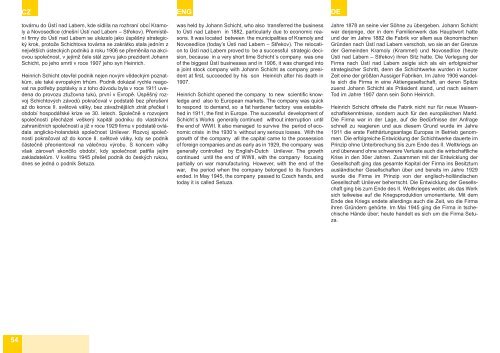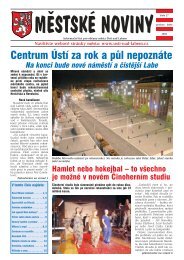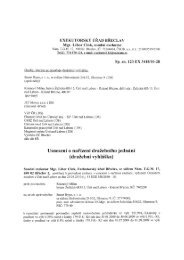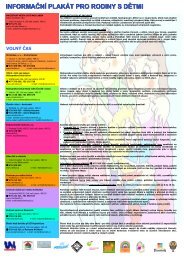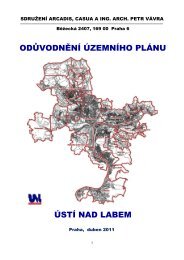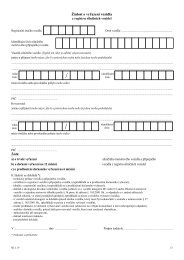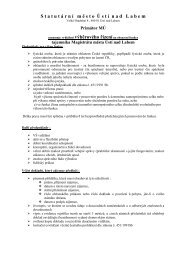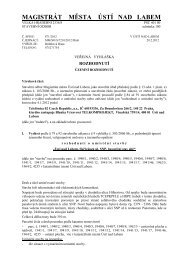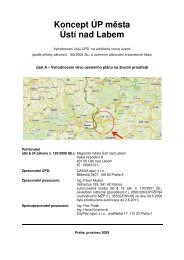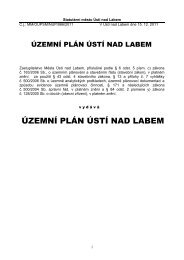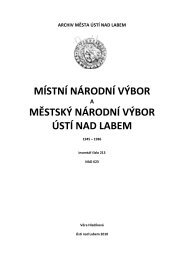Historie a památky města Ústí nad Labem History and monuments of ...
Historie a památky města Ústí nad Labem History and monuments of ...
Historie a památky města Ústí nad Labem History and monuments of ...
Erfolgreiche ePaper selbst erstellen
Machen Sie aus Ihren PDF Publikationen ein blätterbares Flipbook mit unserer einzigartigen Google optimierten e-Paper Software.
54<br />
CZ ENG DE<br />
továrnu do <strong>Ústí</strong> <strong>nad</strong> <strong>Labem</strong>, kde sídlila na rozhraní obcí Kramoly<br />
a Novosedlice (dnešní <strong>Ústí</strong> <strong>nad</strong> <strong>Labem</strong> – Střekov). Přemístění<br />
firmy do <strong>Ústí</strong> <strong>nad</strong> <strong>Labem</strong> se ukázalo jako úspěšný strategický<br />
krok, protože Schichtova továrna se zakrátko stala jedním z<br />
největších ústeckých podniků a roku 1906 se přeměnila na akciovou<br />
společnost, v jejímž čele stál zprvu jako prezident Johann<br />
Schicht, po jeho smrti v roce 1907 jeho syn Heinrich.<br />
Heinrich Schicht otevřel podnik nejen novým vědeckým poznatkům,<br />
ale také evropským trhům. Podnik dokázal rychle reagovat<br />
na potřeby poptávky a z toho důvodu byla v roce 1911 uvedena<br />
do provozu ztužovna tuků, první v Evropě. Úspěšný rozvoj<br />
Schichtových závodů pokračoval v podstatě bez přerušení<br />
až do konce II. světové války, bez závažnějších ztrát přečkal i<br />
období hospodářské krize ve 30. letech. Společně s rozvojem<br />
společnosti přecházel veškerý kapitál podniku do vlastnictví<br />
zahraničních společností a již v roce 1929 firmu v podstatě ovládala<br />
anglicko-hol<strong>and</strong>ská společnost Unilever. Rozvoj společnosti<br />
pokračoval až do konce II. světové války, kdy se podnik<br />
částečně přeorientoval na válečnou výrobu. S koncem války<br />
však zároveň skončilo období, kdy společnost patřila jejím<br />
zakladatelům. V květnu 1945 přešel podnik do českých rukou,<br />
dnes se jedná o podnik Setuza.<br />
was held by Johann Schicht, who also transferred the business<br />
to <strong>Ústí</strong> <strong>nad</strong> <strong>Labem</strong> in 1882, particularly due to economic reasons.<br />
It was located between the municipalities <strong>of</strong> Kramoly <strong>and</strong><br />
Novosedlice (today’s <strong>Ústí</strong> <strong>nad</strong> <strong>Labem</strong> – Střekov). The relocation<br />
to <strong>Ústí</strong> <strong>nad</strong> <strong>Labem</strong> proved to be a successful strategic decision,<br />
because in a very short time Schicht´s company was one<br />
<strong>of</strong> the biggest <strong>Ústí</strong> businesses <strong>and</strong> in 1906, it was changed into<br />
a joint stock company with Johann Schicht as company president<br />
at first, succeeded by his son Heinrich after his death in<br />
1907.<br />
Heinrich Schicht opened the company to new scientific knowledge<br />
<strong>and</strong> also to European markets. The company was quick<br />
to respond to dem<strong>and</strong>, so a fat hardener factory was established<br />
in 1911, the first in Europe. The successful development <strong>of</strong><br />
Schicht´s Works generally continued without interruption until<br />
the end <strong>of</strong> WWII. It also managed to survive the period <strong>of</strong> economic<br />
crisis in the 1930´s without any serious losses. With the<br />
growth <strong>of</strong> the company all the capital came to the possession<br />
<strong>of</strong> foreign companies <strong>and</strong> as early as in 1929, the company was<br />
generally controlled by English-Dutch Unilever. The growth<br />
continued until the end <strong>of</strong> WWII, with the company focusing<br />
partially on war manufacturing. However, with the end <strong>of</strong> the<br />
war, the period when the company belonged to its founders<br />
ended. In May 1945, the company passed to Czech h<strong>and</strong>s, <strong>and</strong><br />
today it is called Setuza.<br />
Jahre 1878 an seine vier Söhne zu übergeben. Johann Schicht<br />
war derjenige, der in dem Familienwerk das Hauptwort hatte<br />
und der im Jahre 1882 die Fabrik vor allem aus ökonomischen<br />
Gründen nach <strong>Ústí</strong> <strong>nad</strong> <strong>Labem</strong> verschob, wo sie an der Grenze<br />
der Gemeinden Kramoly (Krammel) und Novosedlice (heute<br />
<strong>Ústí</strong> <strong>nad</strong> <strong>Labem</strong> – Střekov) ihren Sitz hatte. Die Verlegung der<br />
Firma nach <strong>Ústí</strong> <strong>nad</strong> <strong>Labem</strong> zeigte sich als ein erfolgreicher<br />
strategischer Schritt, denn die Schichtwerke wurden in kurzer<br />
Zeit eine der größten Aussiger Fabriken. Im Jahre 1906 w<strong>and</strong>elte<br />
sich die Firma in eine Aktiengesellschaft, an deren Spitze<br />
zuerst Johann Schicht als Präsident st<strong>and</strong>, und nach seinem<br />
Tod im Jahre 1907 dann sein Sohn Heinrich.<br />
Heinrich Schicht öffnete die Fabrik nicht nur für neue Wissenschaftskenntnisse,<br />
sondern auch für den europäischen Markt.<br />
Die Firma war in der Lage, auf die Bedürfnisse der Anfrage<br />
schnell zu reagieren und aus diesem Grund wurde im Jahre<br />
1911 die erste Fetthärtungsanlage Europas in Betrieb genommen.<br />
Die erfolgreiche Entwicklung der Schichtwerke dauerte im<br />
Prinzip ohne Unterbrechung bis zum Ende des II. Weltkriegs an<br />
und überw<strong>and</strong> ohne schwerere Verluste auch die wirtschaftliche<br />
Krise in den 30er Jahren. Zusammen mit der Entwicklung der<br />
Gesellschaft ging das gesamte Kapital der Firma ins Besitztum<br />
ausländischer Gesellschaften über und bereits im Jahre 1929<br />
wurde die Firma im Prinzip von der englisch-holländischen<br />
Gesellschaft Unilever beherrscht. Die Entwicklung der Gesellschaft<br />
ging bis zum Ende des II. Weltkrieges weiter, als das Werk<br />
sich teilweise auf die Kriegsproduktion umorientierte. Mit dem<br />
Ende des Kriegs endete allerdings auch die Zeit, wo die Firma<br />
ihren Gründern gehörte. Im Mai 1945 ging die Firma in tschechische<br />
Hände über; heute h<strong>and</strong>elt es sich um die Firma Setuza.


